
KL4831RGBIM 2009-07-20
SIZE:320x180mm (Double-sided printing)
80.00 mm
180.00 mm
WS 6502
Instruction Manual
INTRODUCTION
This desktop weather station comes with weather forecasting
capabilities, clock, calendar, day, temperature and humidity
display. It is battery powered with AC-DC charger. It is
recommended to use the charger at all times.
Fig. 1 Front view Fig. 2 Back view
1. SNOOZE / LIGHT BUTTON
2. BASE
3. “ALM SET” BUTTON
4. “+/C/F” BUTTON
5. “HISTORY” BUTTON
6. “MODE“ BUTTON
7. “CHANNEL“ BUTTON
8. “-/RCC“ BUTTON
9. “MAX/MIN“ BUTTON
10. BATTERY COMPARTMENT
11. DC LINE IN JACK
1
2
3
4
5
6
7
8
9
10
11
GETTING STARTED:
It is recommended to set up the remote temperature sensor
before setting up the weather station / clock. See “Configuring
Remote Temperature Sensor(s)” below for more information.
INSTALLING A/C ADAPTER:
1. Remove all “AAA” batteries before plugging in A/D-D/C
adapter. See instructions below.
2. Plug in A/C-D/C adapter to the D/C input jack (11) (see figure
2). A/C-D/C adapter is not included.
BATTERIES INSTALLATION:
1. Open battery compartment (10) at the back of the unit. (see
figure 2)
2. Install / replace with 3x “AAA” size batteries in the compartment.
It is recommended that only alkaline batteries are used.
3. Replace the battery compartment cover (10) at the back of the
unit.
4. A short bleep will be heard to confirm proper installation of
batteries.
BATTERIES SAFETY WARNING:
1. Please read all instructions carefully before use.
2. Install batteries correctly by matching the polarities (+/-).
3. Always replace a complete set of batteries.
4. Never mix used and new batteries.
5. Remove spent batteries immediately.
6. Remove batteries when not in use.
7. Do not recharge and do not dispose of batteries in a fire as
the batteries may explode.
8. Ensure batteries are stored away from metal objects as
contact may cause a short circuit.
9. Avoid exposing batteries to high temperatures, humidity
or to direct sunlight.
10. Keep all batteries out of reach from children. They are a
choking hazard.
11. Please retain packaging for future reference.
SETTING UP THE WEATHER STATION:
The weather station will bleep once when batteries are installed
or the AD/DC adapter is plugged in.
1. The double digits will flash showing the level of your location
above sea level will be seen at the bottom right hand corner of
the display. Press “+ / C / F” button (4) or “- / RCC” button (8)
to change your unit location level above sea level. The sea
level units are in meters (1 meter equals approximately 3.28
feet). Contact your local weather bureau or authorities for more
information if required.
2. Press “HISTORY” button (5) to confirm location of the unit
above sea level.
3. Press “+ / C / F” button (4) or “- / RCC” button (8) to change the
current weather situation of your location. See figure 3 below
for the weather pattern that best resembles your immediate
area.
Figure 3.
4.Press “HISTORY” button (5) to confirm weather pattern.
INTERPRETING THE WEATHER FORECAST SYMBOLS:
1. The weather station requires at least 24 hours to acclimatise to
local weather conditions. The weather station will process and
analyse the weather patterns of the past 24 hours in order to
determine the future weather. The predicted weather forecast
may not accurately reflect the actual weather for your immediate
area till 24 hours have elapsed.
2. The weather station will display the symbols (see figure 3) to
indicate the predicted weather forecast for the next 12 to 24
hours for an area within a radius of approximately 30-50 km.
Note:
1. The weather forecasting is approximately 70% accurate.
Accuracy rate might be lower in extreme weather conditions.
The weather forecast is only for reference and only for domestic
use. Do NOT rely on the weather station for a forecast for any
serious matter including but not limited to: personal health, any
business or financial decisions, and/or agricultural planning. And
certainly NOT for life and death situations.
2. The weather forecast does not display the current weather. It
displays future weather situation.
ADJUSTING THE WEATHER STATION:
1. Press “HISTORY” button (5) for 3 seconds until a bleep is heard.
2. Press “+ / C / F” button (4) or “- / RCC” button (8) to select
between atmospheric pressure units of pascal (hPa) to inch of
mercury (inHg)
3. Press “HISTORY” button (5) to confirm.
4. Press “+ / C / F” button (4) or “- / RCC” button (8) to select
between absolute and relative atmospheric pressure.
5. Press “HISTORY” button (5) to confirm.
6. Press “+ / C / F” button (4) or “- / RCC” button (8) to change your
unit location level above sea level.
7. Press “HISTORY” button (5) to confirm unit location level above
sea level.
8. Press “+ / C / F” button (4) or “- / RCC” button (8) to change the
current weather situation for your location. See figure 3 above
for the weather pattern that best resembles your immediate area.
BAROMETER:
The unit takes approximately 24 hours to process and analyse the
recorded barometric pressure data. Prior to 24 hours, the pressure
trend and weather forecasts may not reflect actual weather
forecast for your area.
READING PRESSURE TREND:
Recorded memory of the barometric pressure changes are
displayed with 3 arrows to show pressure trend.
Note: It is only possible to measure the barometric pressure
trend properly when the unit remains at the same altitude
location. When moving around at different altitudes within
a short period of time, the air pressure and the barometric
pressure will change. The pressure trend will only be correct
and regular if the unit remains at a constant location altitude
for 24 hours or more.
FRONT
BACK
TO RECALL RECORDED PRESSURE HISTORY READING:
The barometric pressure reading is recorded in hourly intervals
and can be recalled and displayed for the previous 12 hours.
Press “History” button (5) repeatedly to view pressure recorded
for the past hours. “-1 HR” indicates the pressure of the previous
hour. The pressure reading history will appear for 20 seconds
before the current pressure reading returns.
TO SYNCHRONISE CLOCK WITH RCC:
1. Where available, the clock will automatically synchronise with
the radio control towers at the following time: 02:03, 03:03,
04:03, 05:03.
2. User may also manually synchronise the clock by following the
instructions below.
3. Hold down the “- / RCC” button (8) for approximately 3 seconds
until symbol is flashing.
4. When this signal is flashing, the clock is attempting to
synchronise with the radio control tower. The symbol will flash
when a strong signal is received and the clock will synchronise
with the radio control tower. This process can take up to 7
minutes. The symbol will stop flashing and will be displayed
once the signal is received and is in synchronisation.
5. The symbol will not be displayed if the clock is not able to
synchronise within this period of time. User may manually
synchronise again at a later time or, the clock will automatically
attempts to synchronise at the above mentioned times.
6. Please note all other clock / weather station settings cease to
function when the clock is in RCC synchronisation mode. Wait
until the clock is no longer attempting to synchronise or it is
synchronising to set other clock and weather station function.
7. If the alarm goes off during synchronisation mode, RCC
synchronisation will cease immediately. Follow the above
instructions again to set synchronisation.
RCC ZONE OFFSET:
This clock is equipped with radio controlled time adjustment. The
user will need to work out the time zone signal they receive at
their current location and make (any) adjustment as required.
This function also allows for daylight saving adjustment. Contact
your local weather bureau or authorities for more information.
1. Press “- / RCC” button (8) once for +1 time zone.
2. Press “- / RCC” button (8) once again for +2 time zone.
3. Press “- / RCC” button (8) once again for -1 time zone.
4. Press “- / RCC” button (8) once again for same time zone.
To set time manually:
1. Hold down the “ALM SET” button (3) for approximately 3
seconds until the display is flashing.
2. Press “+ / C / F” button (4) or “- / RCC” button (8) to change the
hour setting.
3. Press “ALM SET” button (3again. Press “+ / C / F” button (4) or
“- / RCC” button (8) to change the minute setting.
4. Press “ALM SET” button (3) again. Press “+ / C / F” button (4)
or “- / RCC” button (8) to change the year setting.
5. Press “ALM SET” button (3) again. Press “+ / C / F” button (4)
or “- / RCC” button (8) to select between the 'month / date' and
'date/ month' setting.
6. Press “ALM SET” button (3) again. Press “+ / C / F” button (4)
or “- / RCC” button (8) to change the month setting.
7. Press “ALM SET” button (3) again. Press “+ / C / F” button (4)
or “- / RCC” button (8) to change the date setting.
8. Press “ALM SET” button (3) again. Press “+ / C / F” button (4)
or “- / RCC” button (8) to select between 'am / pm' and '24-hour
time' clock setting.
9. Press “ALM SET” button (3) again to change language setting.
10. ENG for English - GE for German - IT for Italian - FR for
French - NE for Dutch - ES for Spanish - DA for Danish.
11. Press “ALM SET” button (3) again to confirm settings. Display
will no longer flash.
TO SEE ALARM TIME:
1. Press “MODE” button (6) once and alarm time 1 will be shown
as indicated by A1.
2. Press “MODE” button (6) again and alarm time 2 will be shown
as indicated by A2.
3. Press “MODE” button (6) again and the current time will be
shown.
TO SET ALARM TIME:
1. Press “MODE” button (6) once and alarm time 1 will be shown
as indicated by A1.
2. Press and hold “ALM SET” button (3) for approximately 3
seconds until A1 flashes.
3. Press “- / RCC” button (8) to change the hour setting.
4. Press “ALM SET” button (3) again.
5. Press “+ / C / F” button (4) or “- / RCC” button (8) to change the
minute setting.
6. Press “ALM SET” button (3) again.
7. When Alarm time 1 [A1] is shown, press 'ALM SET' button (3)
to turn ON and OFF the alarm. The symbol will be shown
when the alarm is on.
8. Press “Mode” button (6) again and alarm time 2 will be shown.
To set alarm time A2, follow the above instructions. Press
“Mode” button (6) again to see current time.
9. The symbol will be shown when alarm A2 is on.
10. The alarm will sound for 120 seconds when the preset alarm
time is reached. Press any button at the back of the clock to
de-activate the alarm. The clock will automatically enter
snooze mode if the alarm is not de-activated.
11. Press the “SNOOZE / LIGHT” button (1) when the alarm is on,
to enter 'snooze' mode. The symbol will flash when the
clock is on 'snooze' mode. The alarm will sound again in 5
minutes. Press any button at the back of the clock to
de-activate the alarm.
12. Please note that alarm time setting ceases to function when
the clock is in RCC synchronisation mode. Wait until
synchronisation has ended before setting the alarm time.
Remote temperature sensors
Fig. 4 Back View Fig. 5 Back view - open
1. Hole to hang the sensor
2. Battery compartment screws
3. “TX” button
4. “RESET” button
5. “Channel 1 2 3” switch
1
2 2
4
3
5
CONFIGURING THE THERMOMETER:
The weather station is equipped to synchronise up to 3 remote
temperature sensors. One remote temperature sensor is included.
Additional remote temperature sensors are available for purchase
separately. Please contact your local distributor to purchase these
sensors.
BATTERIES INSTALLATION:
1. Open battery compartment at the back of the unit by removing
the two small screws (RTS 2) with a Philips head screwdriver.
(see figure 4)
2. Install / replace with 2x “AAA” size batteries in the compartment.
It is recommended that only alkaline batteries are used. Do not
use rechargeable batteries.
3. The weather station is capable of receiving up to 3 different
channels. Select the channel number (1, 2, or 3) by sliding the
“Channel 1 2 3” switch (RTS 5). If you only have 1 remote
temperature sensor, select 1.
4. Press the “reset” button (RTS 4) once and the red light will flash
once.
5. Replace the battery compartment cover at the back of the unit
by tightening the two screws (RTS 2).
INSTALLATION
1. Place the remote temperature sensor at a desired place by
mounting the unit on a screw (screw not included) using the
hole for hanging (RTS 1). Alternatively, the unit can be place on
a flat horizontal surface.
2. The unit can be placed indoor or outdoor. The unit is weather-
proof. Do not submerge unit in water. Do not expose unit to
water for prolonged periods. Avoid accumulation of water and
or snow on unit. Avoid exposing unit to direct sunlight. Remove
unit from the exterior location in extreme or harsh weather
conditions, including but not limited to hurricane, typhoon, and
cyclones seasons. Do not place the unit in area of high winds.
3. Do not place the remote temperature sensor more than 30
meters (98 feet) from the receiving weather station unit. The
remote temperature sensor is more effective if there are no
obstructions and interference between the remote temperature
sensor and the weather station. The remote temperature sensor
might have to be closer than 30 meters if the weather station is
not able to receive signals. This may be due to obstructions
and or interference. The user might need to experiment with
various locations to get the best reception.
4. If there is a change in power source in the main unit (i.e. from
batteries to AC-DC adapter or vice versa), press "TX" button
(RTS 3) on the remote temperature sensors to reconfigure
remote temperature sensors. See figure 5.
CONFIGURING WEATHER STATION UNIT TO RECEIVE
REMOTE TEMPERATURE SIGNALS:
1. Follow the above instructions to set up remote temperature
sensor.
2. Press “Channel” button (7) on weather station for 3 seconds.
The symbol will flash. This will reset all temperature
memories.
3. The weather station will begin scanning for signals for channel 1.
As soon as signals are received from channel 1, the temperature
will be displayed. The weather station will automatically scan for
other channels. It will scan each channel for approximately 3
seconds before skipping to the next channel.
4. Once all your channels are received by the unit, press “Channel”
button (7) once to confirm the channel. The symbolwill no
longer be displayed.
5. The weather station will receive a new signal automatically
every 30 seconds to update the remote temperature.
6. Press “Channel” button (7) on weather station repeatedly to
select between channel 1, channel 2, and channel 3.
7. The symbol will be displayed on the weather station unit if any
of the remote temperature sensor's batteries need replacing.
TEMPERATURE MEMORY:
Press “Max / Min” button (4) to display maximum recorded
temperature, minimum recorded temperature and current
temperature. “max” indicates maximum temperature. “min”
indicates minimum temperature
TEMPERATURE DISPLAY:
1. The “IN” temperature displays the indoor temperature. It is the
temperature of the actual location of the weather station.
2. The “OUT” temperature displays the temperature of the remote
temperature sensors.
3. Press “Channel” button (7) on weather station repeatedly to
display the temperature of channel 1, channel 2, and channel 3.
CELSIUS / FAHRENHEIT:
Press “+ / C / F” button (4) to select between displaying the
temperature in Celsius or Fahrenheit.
TEMPERATURE TREND:
1. Indicates the temperature trend is increasing.
2. Indicates there is a stable temperature trend.
3. Indicates the temperature trend is decreasing.
WARNINGS
1. Do not subject the unit to excessive force, shock, dust,
temperature or humidity.
2. Do not immerse the unit in water.
3. Dispose the complete unit when the internal battery is no longer
charging or when the unit is no longer displaying the
temperature and / or humidity.
4. Do not remove any screws.
5. Do not dispose this unit in a fire. IT MAY EXPLODE.
6. Keep unit away from small children. The unit or parts of the unit
might be a choking hazard.
7. Never attempt to recharge the batteries by any other methods.
8. Dispose the unit legally and environmentally.
9. Recycle when possible.




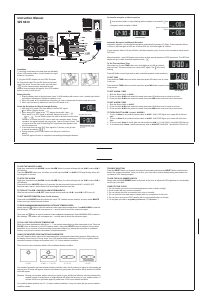


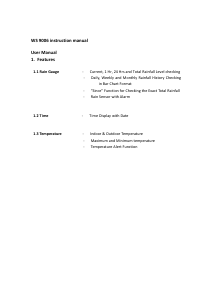
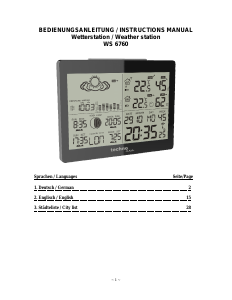
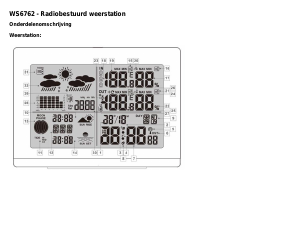
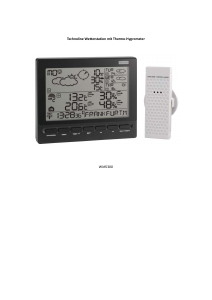
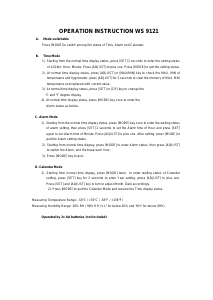
Praat mee over dit product
Laat hier weten wat jij vindt van de Technoline WS 6502 Weerstation. Als je een vraag hebt, lees dan eerst zorgvuldig de handleiding door. Een handleiding aanvragen kan via ons contactformulier.